Romanian
Army
|
Introduction
In
fear of losing more territory, on the 23 November 1940, the
Romanian government adhered to the Tripartite Pact alliance
that was signed by Germany, Italy and Japan. Prince Michael
became heir of the throne however General Antonescu who was
Commander-and-Chief of the military took control of the whole
country.
The Germans were aware of the importance of the Ploesti oil
fields. They proceeded to support Antonescu who had sought a
military alliance.
On 22 June 1941, 325,685 Romanian troops followed their German
allies towards Russia. By the end of July 1941, the Romanian
territories of Besarabia and Northern Bucovina were liberated
but in the process Romania lost 4112 men plus 5506 missing and
another 12,120 men wounded.
On 22 August, King Michael promoted General Antonescu to Field
Marshal. Antonescu and about 17 Romanian officers received the
conveted Knigth's Cross of the Iron Cross, twice the numbers
the Germans awarded than any other allies.
|
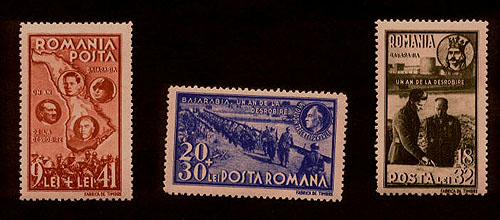
Odesa
On 27 July the already over stretched German Army required Romania's
4th Army to capture the important port railway center of Odesa.
On August 5, the Romanian Divisions under V Corps crossed the
River Dnestr. Its mission was to descend on the Black Sea coast
in the rear of the Russian forces, which were being heavily
reinforced with manpower to defend Odesa.
The battle involved in tacking the major port of Odessa between
2 and 28 August, cost the Romanian 4th Army losses were 27,307
men, the attempt to take Odessa had failed. On 28 August the
Romanian assault resumed without further significant success.
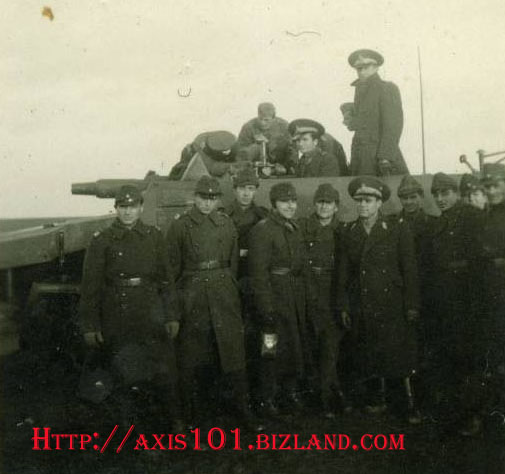
Between 28 August and 11 September, the Romanians lost another
31,552 casualties. A third assault to retake Odesa was attempt
by the Romanian Armies on the 9 to 21 September. Fresh Romanian
troops were deployed, bringing 4th Army up to 12 infantry divisions,
3 cavalry brigades and 2 fortress brigades. Meanwhile the Russian
Coastal Army, which was counterattacking, was being reinforced
with men and large ammunition stocks from the sea. After much
stubborn defense from the Russian coastal forces, it was decided
to withdrawal the last of the Soviet garrison on the night of
16 October.
The Romanians finally took Odesa but lost another 7684 dead,
25,624 wounded and 5993 missing. The total Russian commitment
had exceeded 120,000 men, on whom 60,000 casualties were inflicted.
|
|
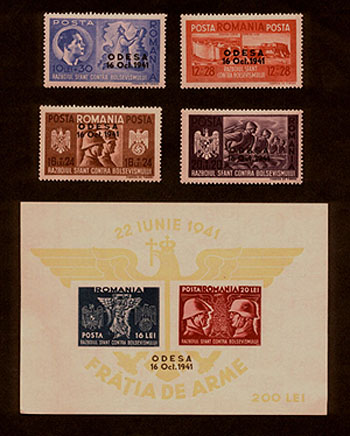
Romania Holy
War against Bolshevism
The capture of Odesa was commemorated on a set of three semi-postal
stamps and a souvenir sheet, which show the overprint and the
date it was captured "ODESA/16 Oct. 1941." These stamps captured
"ODESA/16 Oct. 1941."have the inscription "RAZBOIUL SFANT CONTRA
BOLSEVISMULUI" (Holy War against Bolshevism). The sheet shows
two stamps with a face value, in the background it shows the
Romanian coat of arms with the inscriptions "22 IUNIE 1941"
on top, and below the "FRATIA DE ARME" (Brotherhood in Arms).
These stamps went on sale on 16 October 1941 for two months. |
|
Stalingrad
During autumn 1941, the Romanian 3rd and 4th Army and 80% of
Romania's fighting divisions were dispersed amongst the German
6th and 17th, and 1st and 4 Panzer Armies.
The 3rd Romanian Army with eleven divisions was initially deployed
along the Don River bend with the mission of defending 150Kms
while the German 6th Army made head ways towards Stalingrad.
The Romanian 4th Army, was tasked to hold 200Kms of front-line.
The 3rd Romanian Army eventually received some relief support
from the Hungarian 2nd and Italian 8th Armies. Unfortunately
like the rest of the Axis forces they were missing heavy weapons,
supplies and manpower. Meanwhile the Russian forces new about
these weaknesses and was preparing to attack the Axis flanks.
When the Russian winter counter-offensive was launched on 19
November 1942, the Romanian 4th Army was considerably reduced
in manpower and was guarding a vast opened area devoid of any
natural cover.
During the summer of 1942, the Romanian 4th Army had 101,875
men by November it amounted to 75,380 men. The Russians launched
its offensive on 20 November against the 3rd and 4th Romanian
Armies.
By 4 December 1942, the Romanian 4th Army was attacked by 149,000
Russian troops and 635 tanks, which destroyed the weak forces
of the Romanian 4th Army and German 57th Panzer Corps. During
the battle of Stalingrad the 20th Romanian Infantry Division
and the 1st Romanian Calvary Division were destroyed.
The Russian attack on the Romanian 3rd Army met stiff resistance,
which managed to make a very difficult fighting withdrawal.
|
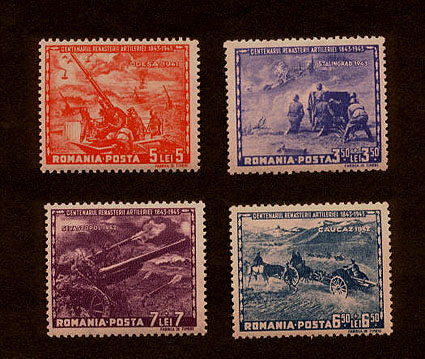
Romanian Campaign Issues
On November 10, 1943 the Romanian post office issued a set of six values commemorating
the Centenary of Romanian Artillery.
Notice the battle scenes and the names of the Russian cities that the Romanian Army participated:
Odesa 1941
Caucasus 1942
Sevastopol 1942
Stalingrad 1943
|
|
Caucasus
For the German 1942 summer offensive to take
Crimea, the Romanian Mountain Corps (1st and 4th Mountain Divisions)
were instrumental in neutralizing the Russian partisan threat.
The Romanian Cavalry Corps (5th, 6th, & 9th Cavalry Divisions)
covered the right flank of the German 17th Army as it advanced
into the Caucasus.

The 2nd and 3rd Romanian Mountain Divisions were also used in
the drive into the Caucasus as was the 19th Infantry, 6th and
9th Cavalry Divisions. These divisions were employed mainly
on coastal defense and anti-Partisan duties throughout 1943.
However by April 1944, Romanian morale had deteriorated. The
Soviets launched a major assaulted in the Crimea, the defending
Romanian 10th Infantry and 6th Cavalry Divisions collapsed.
The rest of these divisions were evacuated and sent to Romania
for refitting. The Romanian Army was needed to defend Besarabia
and in May 1944 the 3rd and 4th Armies were back in defensive
positions.
In August the Russians once again opened their offensive causing
the Romanian Front to collapse. By 23 August 1944, young King
Michael signed an armistice with Russia under the terms that
the Romanian government was obliged to take arms against their
former Axis partner.
King Michael had Antonescu arrested (he was tried and executed).
The Germans now found themselves fighting their former Axis
partner. Between 22 June 1941 and 23 August 1944, Rumanian losses
amounted to 71,000 killed, 234,000 wounded and 310,000 missing
or prisoners of war. |
|
Romanian
Postal History
The Romanian army postal service (Oficiul Postal Militara OPM) was organized
in principle separate from the German army postal service.
The Romanian government provided free franking privileges for
military personnel serving in Russia. Each military unit was assigned
a two or three OPM code number. There were no regulations on showing the
word field post on Letters and cards.
Agreements to use Feldpost services between the German and Romanian
servicemen came in 1942, however a small postal charge was applied.
Additional domestic postal rate was applied for mail weighing up
to 1000gms. By December 1943, Feldpost was free of charge for German
and Romanian servicemen came in 1942, however a small postal charge
was applied. An additional domestic postal rate was applied for
mail weighing up to 1000gms.
Free franking cards showing
Prince Michael imprint and the Romanian coat of arms were issued,
however, certain postal cards valued from 3Lei to 10Lei were also
available to military personnel.
All military mail was subject for
censorship, mail had usually rectangular or oval censor markings.
Sealing tapes were also used on letters that were examined. Mail
sent from the Eastern Front bore "De Pe Front" markings.
|
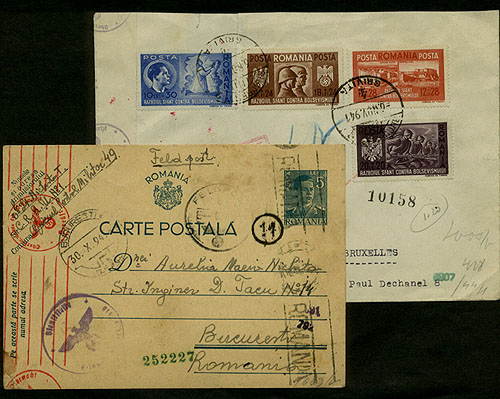
Romanian Postal Mail
|
|
On
the top is an interesting cover that was mailed to Bruxelles, Belgium on
6 November 1941. The postal cover shows the complete set of the anti-bolshevik
stamps. It was Register and has both Romanian and German censor markings and
a German sealing tape.
Romanian units were attached to German Divisions, which used the German Feldpost
service as shown in the example above. The field card with a 5 Lei postal charge
was mailed from the Eastern Front and shows both Romanian and German Field cancels.
In addition, it has both Romanian and German Censor markings.
|
|
By December 1943, Feldpost was free of charge for German and
Romanian servicemen. A 20Rpf fee was charge for packages weighing from 250 to 1000gms.
All packages were subject for customs inspection and censorship. Official mail was sent
free for mail weighing up to 1500gms. Letters and postcards up to 100gms could be sent
free from Romania to Germany, but normal fees were charge for all other mail.
The personal effects of deceased members of the German forces were sent free up to 1500gms.
Registered official mail up to 1000gms was allowed in Romania, and insured packages were
permitted for values up to 72,000Lei or 1200RMs.
|
[ Front
Page ] [Top ] [Previous
Page [Next Page]
|





